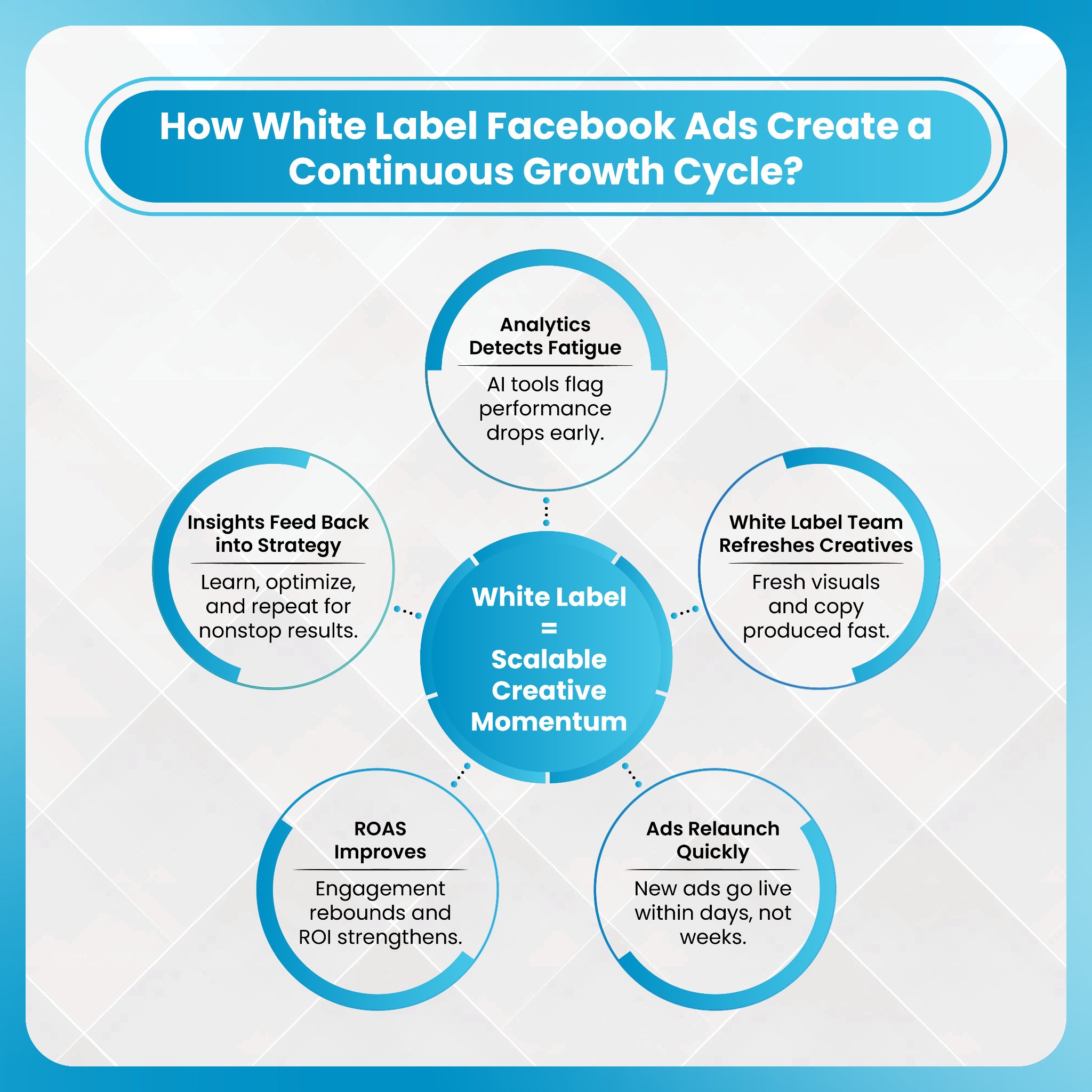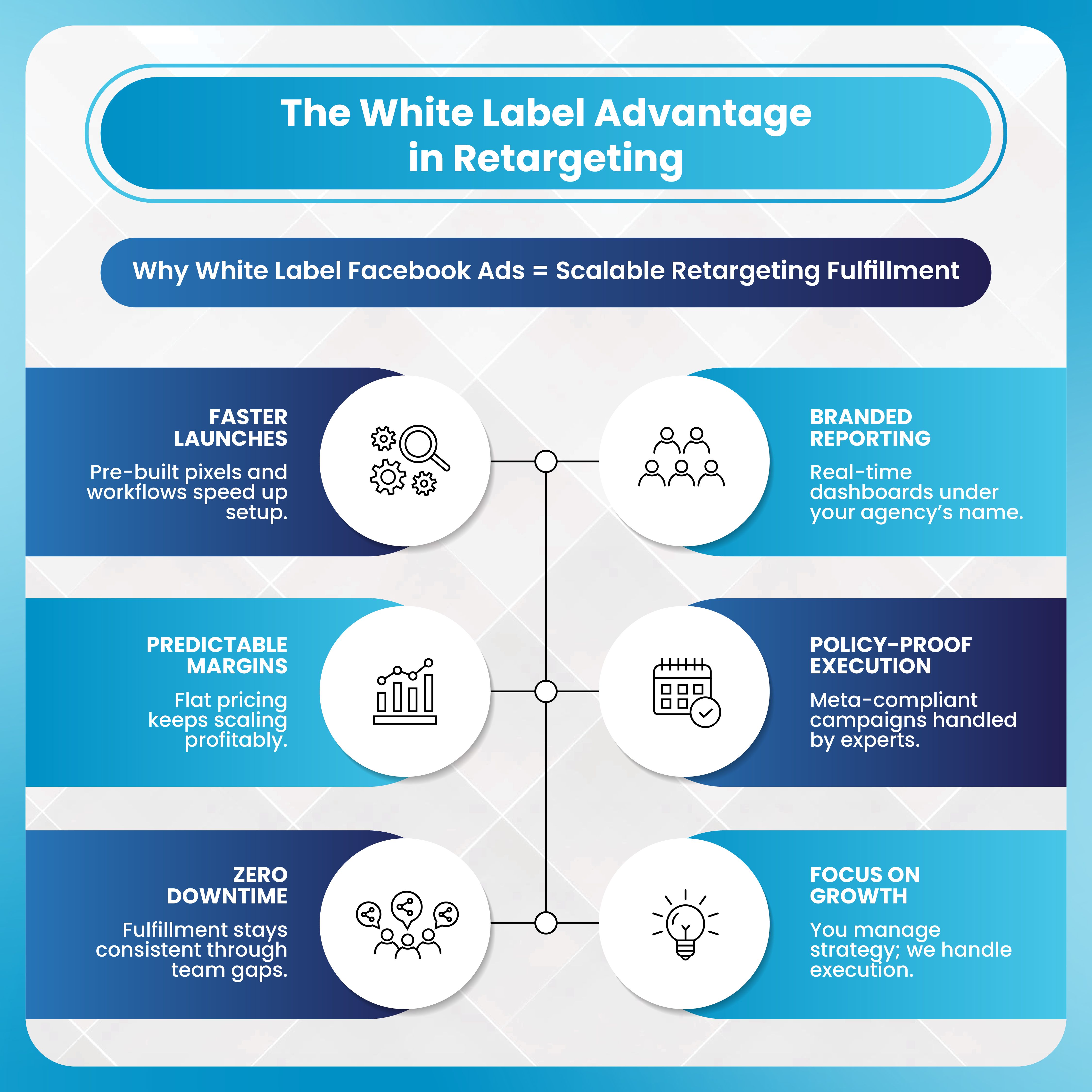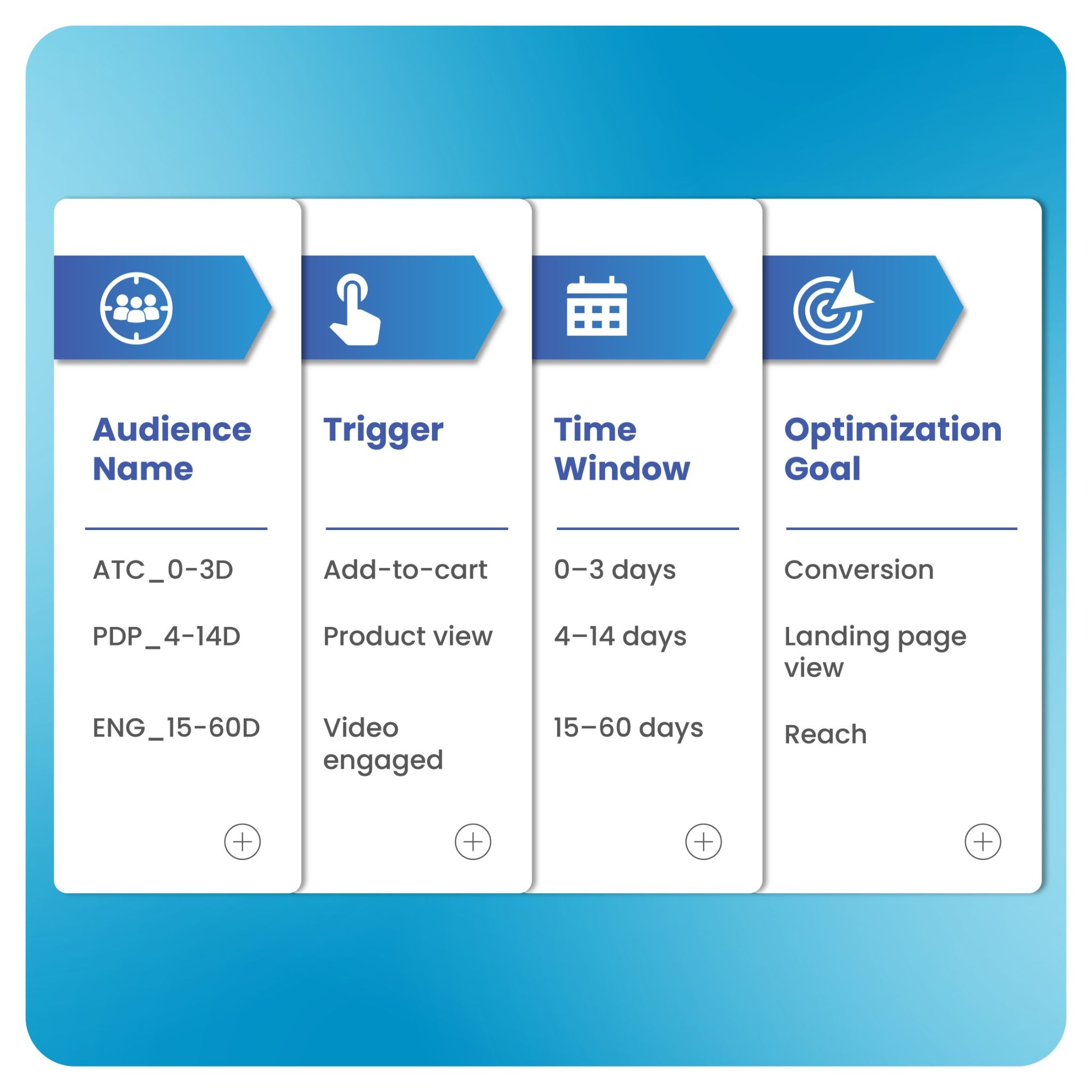Digital advertising is noisier than ever. Every day, users scroll past hundreds of ads, skip pre-roll videos, and block notifications. Attention is scarce, and competition for that attention is expensive. Facebook’s average CPMs (cost per thousand impressions) have climbed steadily over the past two years, with advertisers now paying anywhere between $10 and $20 per thousand views, depending on industry. For agencies managing multiple client accounts, that shift changes the math on profitability.
At the same time, privacy updates and data loss across browsers and devices have made first-touch conversions harder to achieve. That’s why retargeting has evolved from a supporting tactic into a central part of an agency’s ROI strategy. According to WebFX, about 70–77% of marketers actively use Facebook or Instagram retargeting to improve conversion rates and campaign efficiency. And the payoff is clear: aggregated research compiled by DemandSage shows that retargeted users are up to 150% more likely to convert than cold audiences.
For agencies, the opportunity isn’t just to run a few retargeting ads—it’s to build retargeting ecosystems that connect audience signals, creative sequences, and measurement loops into a repeatable, scalable system. This post lays out a blueprint agencies can use to design and resell those systems, powered by white label Facebook Ads services that handle the execution behind the scenes while the agency stays focused on strategy and growth.
The Ecosystem Concept — What a Retargeting Ecosystem Looks Like?
A retargeting ecosystem is not a single campaign. It’s an integrated framework that combines audience data, triggers, creative messaging, and analytics into a continuous loop of engagement and optimization. Think of it as a living system that adapts to where users are in their journey instead of showing everyone the same ad repeatedly.
A healthy ecosystem includes:
- Source Events: website visits, social engagements, video views, or lead magnet downloads.
- Segmentation Logic: cart abandoners, product viewers, pricing-page visitors, and loyal customers are all treated differently.
- Sequential Ad Funnels: creative messages that evolve as the user moves closer to purchase.
- Measurement and Attribution Loops: event tracking and analytics that feed learnings back into the system.

Image Source: Flipkart Commerce Cloud
This approach beats ad-by-ad thinking because it creates persistent lifetime value (LTV) uplift. Instead of one-off conversions, you build brand memory over time. For example, a user who views a product but doesn’t buy might first see a testimonial video, then a limited-time offer, and finally a personalized discount. That sequence creates momentum—and that momentum compounds across audiences.
In practice, a simple retargeting map looks like this:
Source → Friction Point → Audience Segment → Sequential Ads → Conversion & Measurement
Once this flow is automated, agencies can scale it across clients and industries while maintaining consistent ROI delivery.
Why White Label Facebook Ads Are the Right Fulfillment Model for Agencies?
As agencies grow, managing ad fulfillment becomes one of the biggest operational bottlenecks. Every new client adds layers of campaign management, creative testing, reporting, and optimization—all of which demand both technical precision and repeatable workflows. Scaling these systems requires more than just ad expertise; it needs process discipline, tools, and a dependable structure for delivery.
Agencies typically have three fulfillment options:
1. The In-House Model: Control Comes at a Cost
An internal media buying team gives you full visibility and creative control. However, that control comes with real expenses—salaries, benefits, ongoing training, and management overhead.
Even a small in-house ad department needs dedicated specialists:
- A Meta-certified ads manager for campaign setup and optimization.
- A creative strategist for visuals and copy.
- A data analyst for performance tracking and reporting.
That’s a significant investment before you’ve even signed your next client. Plus, bandwidth becomes a limiting factor—your team can only handle so many accounts before quality starts to dip. Training new hires or covering staff turnover further slows growth.
2. The Freelancer Route: Flexibility Without Consistency
Freelancers are a tempting middle ground. They’re affordable and easy to find. But they can also create inconsistency in delivery and communication.
Common challenges agencies face with freelancers include:
- Lack of standardized campaign structures or naming conventions.
- Variable communication speed and reporting quality.
- Difficulty ensuring adherence to Meta’s ever-changing ad policies.
While freelancers can help fill short-term gaps, they rarely provide the consistency needed for long-term scalability or seamless client experiences.

The White Label Model: Scalable Fulfillment Without the Overhead
A white label Facebook Ads partner offers the best of both worlds—expert-level execution without the cost and complexity of building your own team. These providers already have the infrastructure, systems, and personnel to deliver high-quality campaigns at scale.
Each approach has its advantages and drawbacks, but for agencies that want to scale profitably and maintain focus on client relationships, white label Facebook Advertising fulfillment is often the most sustainable model.
Here’s how a white label model helps agencies grow faster and operate more efficiently:
- Faster Onboarding and Launches: White label partners come equipped with pre-built systems for pixel setup, Conversions API, and campaign naming conventions. That means new client campaigns can go live in days instead of weeks. The technical foundation is already in place, minimizing errors and delays.
- Unified, White-Labeled Reporting: Most providers (like DashClicks) offer a unified reporting dashboard that agencies can fully rebrand. Clients see consistent, professional reports with your agency’s logo, not your vendor’s. This transparency strengthens client trust and gives you a single view of all accounts in real time.
- Predictable Margins and Cost Control: White label services use flat, transparent pricing—usually per account or ad spend tier—so agencies can forecast profit margins easily. There are no surprises or hidden costs, and scalability becomes predictable. You can take on five or fifty clients with the same confidence in fulfillment.
- Policy Compliance and Expert Oversight: Meta’s ad ecosystem changes constantly. From creative approval rules to conversion tracking protocols, compliance mistakes can get campaigns flagged or accounts restricted. White label teams specialize in Facebook Ads and stay current on policy updates. They also provide SLAs (service-level agreements), giving you guaranteed delivery timelines and performance standards.
- Focus on Strategy and Client Growth: By outsourcing the execution layer—campaign building, creative testing, performance optimization—you free up your internal team to handle higher-value work: client strategy, upselling, retention, and relationship management. Your clients still view your agency as their trusted partner, while fulfillment runs quietly in the background.
The Result: Scale Without Stress
When done right, white label fulfillment transforms your agency into a scalable machine. You maintain full ownership of the client relationship and strategic direction while delegating the technical and repetitive tasks to specialists. There’s no need to hire, train, or micromanage—just consistent delivery that grows with your business.
For most digital agencies, the math is simple:
- Lower costs than hiring full-time staff.
- Greater reliability than managing multiple freelancers.
- Faster, more consistent results than handling everything in-house.
That combination makes white label Facebook Ads the most efficient fulfillment model for agencies that want to expand their client base without sacrificing quality or profitability.

Core Building Blocks: Audiences, Signals, and Rules
Every strong retargeting ecosystem starts with precision in audience design and signal capture.
Audience Design
- Micro-Segments: Create specific audiences for actions like product views, cart abandonment, pricing page visits, video engagement, and repeat visitors.
- Lookalike Seeding: Expand reach by building lookalikes of top converters or high-value customers.
- Exclusions: Always exclude converted users from early-funnel retargeting to avoid wasting spend.
Signal Architecture
- Implement both Facebook Pixel and Conversions API (CAPI) to ensure data accuracy in a privacy-first world.
- Combine CRM data, email engagement lists, and offline event matches to bridge the gap between online and offline conversions.
- Use server-side signals to maintain consistency even when browser tracking is limited by privacy restrictions.
Rules and Frequency Capping
1. Set recency windows:
- 0–3 days: Show urgency-driven messages (“You left this behind!”).
- 4–14 days: Introduce testimonials or offer-based content.
- 15–60 days: Share long-term value messages or educational assets.
2. Cap frequency to avoid ad fatigue—no more than 3–5 impressions per user per week in the same cohort.
3. Adjust bidding strategies by audience size and stage, optimizing for conversions in high-intent segments and link clicks in colder retargeting groups.
Sample Audience Setup:

This structure ensures your ecosystem captures every touchpoint while maintaining efficiency and compliance.
Creative Systems That Scale Sequencing and Personalization
Creative is where strategy meets emotion. In retargeting, sequencing is key—the goal is to match creative to mindset. You’re not just reminding users; you’re guiding them through micro-decisions until they convert.
1. The Creative Stack
- Hero Creative: Showcase your product or service clearly.
- Social Proof: Add reviews, UGC clips, or case study snippets.
- Offer Layer: Time-bound discounts or bonuses.
- Urgency/Closing Ad: Scarcity-based callouts to push conversions.
Dynamic Product Ads (DPAs) automatically pull items from your catalog to show users exactly what they viewed. These are perfect for e-commerce. For service brands, video-first retargeting or UGC-based creatives perform better because they humanize the message.
2. Testing Matrix: Test one variable at a time:
- Hook: First three seconds of a video or opening line of ad copy.
- CTA: “Shop Now” vs. “Learn More.”
- Offer: 10% off vs. free shipping.
Allow each variation to gather statistical significance before making changes—ideally 7–10 days or until 95% confidence is achieved.
3. Example Cadence: For a 3-week eCommerce retargeting sequence:
- Week 1: Product video + carousel ad
- Week 2: Customer testimonial + discount code
- Week 3: Urgency creative + free shipping offer
Expect CTRs between 2–4% and conversion lifts of up to 120% over cold traffic benchmarks.
Measurement & Attribution for Ecosystem Performance
You can’t optimize what you don’t measure. Successful retargeting ecosystems use a clear KPI hierarchy.
Core KPIs
- Revenue per visitor
- ROAS by audience cohort
- Incremental conversions (vs. holdout group)
- LTV lifts over 90 days
Attribution in a Privacy-First World
Since pixel-based attribution is increasingly fragmented, use blended models that combine:
- Event Lifts: Comparing the performance of exposed vs. unexposed users.
- Holdout Audiences: Excluding a small control group to measure true incremental impact.
- Conversion Modeling: Combining Meta data with CRM Software and email metrics.
Reporting Templates
- Monthly Reports: Focus on short-term efficiency (ROAS, CPA, frequency).
- Quarterly Reviews: Emphasize long-term value (LTV growth, repeat purchase rate).
Benchmark example: For most industries, a healthy retargeting ROAS ranges from 6x to 12x, depending on product margin and target audience quality.
Operational Playbook: Processes, SLAs, and Handoffs
A scalable system needs operational discipline. Here’s how to run fulfillment smoothly with a white label partner:
Onboarding Checklist
- Access: Business Manager, Pixel, and CAPI integration.
- Creative assets: Image/video library and copy guidelines.
- Audience mapping: CRM lists, website triggers, and exclusions.
- Naming conventions: Standardized to maintain consistency.
Governance & SLAs
- Creative approval: within 48 hours.
- QA test runs: before each campaign launch.
- Reporting cadence: weekly performance snapshots, monthly reviews.
- Escalation path: direct Slack or dashboard communication channel.
Pricing & Margins
Agencies often mark up white label execution by 30–60%. For example:
- White label cost: $500/month
- Client-facing retainer: $800/month
This model keeps gross margins predictable while delivering consistent quality.
90-Day Rollout Timeline
- Days 1–30: Setup tracking, audiences, and creatives.
- Days 31–60: Launch initial campaigns, optimize CTR and CPA.
- Days 61–90: Expand audiences, add sequencing, refine reporting.
Risk Management & Compliance
Facebook’s advertising policies and global privacy regulations are constantly evolving. Agencies that plan ahead minimize disruption.
Best Practices
- Use server-side tracking and CAPI to mitigate data loss from iOS or browser changes.
- Implement consent management tools to collect and respect user preferences.
- Maintain creative backups that comply with Meta’s ad policies on restricted content, claims, and targeting.
Contingency Steps for Performance Drift
- Monitor CTR and conversion trendlines weekly.
- If performance drops by 20%+, test attribution windows or adjust bid caps.
- Re-seed lookalike audiences from your latest converters.
- Audit pixel and CAPI connections for errors.
A white label partner with compliance expertise helps keep client accounts healthy and reduces downtime during policy updates.
Growth Levers: Scaling Ecosystems Across Channels
Once your Facebook retargeting ecosystem is stable, extend it across channels.
Cross-Channel Expansion
- Sync Facebook audiences with Instagram, Messenger, and even Connected TV (CTV) for multi-platform visibility.
- Reuse top-performing creatives and copy frameworks across paid search, YouTube, or LinkedIn.
- Create unified customer journeys that move from social to owned assets like email or SMS.
Portfolio Growth
Bundle retargeting with:
- SEO and content marketing (for awareness)
- Email nurturing (for engagement)
- CRM remarketing (for reactivation)
Example packaging strategy:
- Starter: Retargeting + pixel setup
- Growth: Full-funnel retargeting + creative refresh + reporting
- Enterprise: Multi-channel retargeting + email sync + analytics dashboard
Each tier creates predictable recurring revenue for agencies while improving client retention.
How DashClicks Helps Agencies Build Retargeting Ecosystems?
DashClicks enables agencies to launch and manage complete retargeting ecosystems through its white label Facebook Ads services. The service includes everything from pixel and Conversions API setup to creative development, campaign management, and analytics reporting—all fully brandable for agencies.
Their unified dashboard streamlines workflow automation, client communication, and real-time performance tracking, allowing agencies to scale confidently while maintaining their brand identity. With DashClicks, agencies get the execution power of a full Facebook Ads team—without hiring one.
Two Tactical Micro-Case Studies
Case A: Mid-Market E-commerce Brand
Challenge: High cart abandonment (70% rate) and inconsistent ROAS.
Approach:
- Built segmented audiences: cart abandoners (0–3 days), product viewers (4–14 days), and repeat visitors (15–60 days).
- Created a 3-step creative sequence with dynamic product ads, testimonial videos, and urgency offers.
- Used Meta Pixel + CAPI integration for better attribution.
Results after 90 days:
- ROAS improved from 4.2x to 9.5x.
- Conversion rate increased by 138%.
- Cart abandonment dropped by 23%.
These results align with industry averages cited by DemandSage, showing up to 150% lift in conversion with structured retargeting.
Case B: B2B Lead Generation Firm
Challenge: Weak lead nurturing between awareness and webinar signup.
Approach:
- Retargeted site visitors with educational video ads and case studies.
- Built a sequential funnel: content engagement → webinar registration → lead form retargeting.
- Tracked performance with holdout audiences for true incremental ROI.
Results after 90 days:
- Cost per qualified lead dropped 32%.
- Conversion from ad click to SQL improved 47%.
- LTV of nurtured leads doubled within six months.
Both cases show how structured retargeting ecosystems outperform isolated campaigns and give agencies measurable, repeatable growth.
Quick-Start Checklist & 30/60/90 Day Action Plan
First 30 Days
- Audit client tracking setup (Pixel + CAPI).
- Segment core audiences and exclusions.
- Launch first creative tests.
Next 60 Days
- Build multi-step retargeting sequences.
- Implement holdout testing and frequency caps.
- Review weekly metrics with your white label partner.
By Day 90
- Expand audiences using lookalikes.
- Introduce channel integrations (Instagram, CTV).
- Optimize reporting for client transparency.
Once you see incremental lift, pilot the same framework for another client. Document, measure, and repeat—your agency now owns a scalable retargeting engine.
Conclusion: The Unique Agency Opportunity
Retargeting ecosystems are no longer optional—they’re essential for sustainable ad ROI. Agencies that master them control the most valuable stage of the funnel: conversion and retention.
By partnering with a trusted white label Facebook Ads provider like DashClicks, agencies can deliver sophisticated results without building an internal media team. The outcome is higher client satisfaction, better retention, and scalable recurring revenue.



.svg)

.svg)
.svg)
.svg)
.svg)
.svg)

.svg)




.svg)
.svg)
.svg)
.svg)
.svg)